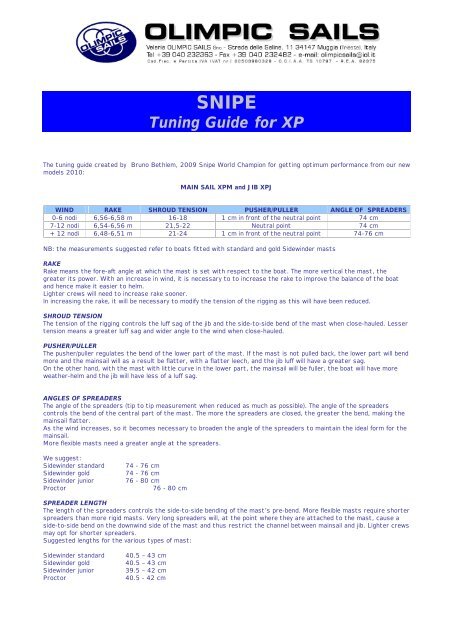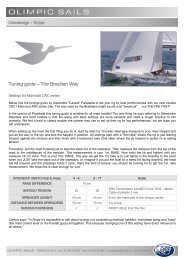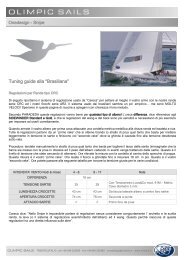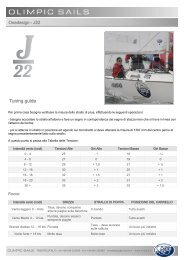SNIPE Tuning Guide for XP - Olimpic sails
SNIPE Tuning Guide for XP - Olimpic sails
SNIPE Tuning Guide for XP - Olimpic sails
You also want an ePaper? Increase the reach of your titles
YUMPU automatically turns print PDFs into web optimized ePapers that Google loves.
<strong>SNIPE</strong><br />
<strong>Tuning</strong> <strong>Guide</strong> <strong>for</strong> <strong>XP</strong><br />
The tuning guide created by Bruno Bethlem, 2009 Snipe World Champion <strong>for</strong> getting optimum per<strong>for</strong>mance from our new<br />
models 2010:<br />
MAIN SAIL <strong>XP</strong>M and JIB <strong>XP</strong>J<br />
WIND RAKE SHROUD TENSION PUSHER/PULLER ANGLE OF SPREADERS<br />
0-6 nodi 6,56-6,58 m 16-18 1 cm in front of the neutral point 74 cm<br />
7-12 nodi 6,54-6,56 m 21,5-22 Neutral point 74 cm<br />
+ 12 nodi 6,48-6,51 m 21-24 1 cm in front of the neutral point 74-76 cm<br />
NB: the measurements suggested refer to boats fitted with standard and gold Sidewinder masts<br />
RAKE<br />
Rake means the <strong>for</strong>e-aft angle at which the mast is set with respect to the boat. The more vertical the mast, the<br />
greater its power. With an increase in wind, it is necessary to to increase the rake to improve the balance of the boat<br />
and hence make it easier to helm.<br />
Lighter crews will need to increase rake sooner.<br />
In increasing the rake, it will be necessary to modify the tension of the rigging as this will have been reduced.<br />
SHROUD TENSION<br />
The tension of the rigging controls the luff sag of the jib and the side-to-side bend of the mast when close-hauled. Lesser<br />
tension means a greater luff sag and wider angle to the wind when close-hauled.<br />
PUSHER/PULLER<br />
The pusher/puller regulates the bend of the lower part of the mast. If the mast is not pulled back, the lower part will bend<br />
more and the mainsail will as a result be flatter, with a flatter leech, and the jib luff will have a greater sag.<br />
On the other hand, with the mast with little curve in the lower part, the mainsail will be fuller, the boat will have more<br />
weather-helm and the jib will have less of a luff sag.<br />
ANGLES OF SPREADERS<br />
The angle of the spreaders (tip to tip measurement when reduced as much as possible). The angle of the spreaders<br />
controls the bend of the central part of the mast. The more the spreaders are closed, the greater the bend, making the<br />
mainsail flatter.<br />
As the wind increases, so it becomes necessary to broaden the angle of the spreaders to maintain the ideal <strong>for</strong>m <strong>for</strong> the<br />
mainsail.<br />
More flexible masts need a greater angle at the spreaders.<br />
We suggest:<br />
Sidewinder standard 74 - 76 cm<br />
Sidewinder gold 74 - 76 cm<br />
Sidewinder junior 76 - 80 cm<br />
Proctor 76 - 80 cm<br />
SPREADER LENGTH<br />
The length of the spreaders controls the side-to-side bending of the mast’s pre-bend. More flexible masts require shorter<br />
spreaders than more rigid masts. Very long spreaders will, at the point where they are attached to the mast, cause a<br />
side-to-side bend on the downwind side of the mast and thus restrict the channel between mainsail and jib. Lighter crews<br />
may opt <strong>for</strong> shorter spreaders.<br />
Suggested lengths <strong>for</strong> the various types of mast:<br />
Sidewinder standard 40.5 – 43 cm<br />
Sidewinder gold 40.5 – 43 cm<br />
Sidewinder junior 39.5 – 42 cm<br />
Proctor 40.5 - 42 cm
JIB HEIGHT<br />
The jib has three adjustments that need to be juggled with: the tension of the sheet, the barber hauler and the strop<br />
regulating the height of the jib above the round of beam of the deck. When close-hauled, the jib should just touch the<br />
deck. There should be no space between jib and deck, but nor should it be so low as to <strong>for</strong>m a fold on deck. In light winds,<br />
it is best to keep the jib low to enable a better exit angle.<br />
The tension of the sheet controls the shape of the sail in the lower part of the jib. With a slack sheet, the lower part of<br />
the jib will be fuller, giver greater power and a wider angle; on the contrary, a tightly-hauled sheet gives a flatter jib with<br />
less power but a lesser angle. The sheet will need to be adjusted constantly.<br />
The jib block (<strong>for</strong>wards or backwards) controls the opening of the jib exit. This adjustment must be done at the same time<br />
as the tensioning of the jib sheet. To facilitate the view of the opening of the jib exits, I recommend placing a mark on the<br />
spreaders 31 cm from the side of the mast. The extension of the leech of the jib must be positioned between this mark<br />
and the point of the spreaders, and never inboard of the mark.<br />
ADJUSTING THE MAIN SHEET<br />
The tension of the main sheet regulates the angle of the sail with regard to the boat. The mainsail has three telltales<br />
that should always be flying. If the mainsail is hauled in too much, the upper telltale will not fly and the boat loses speed.<br />
Remember that the mainsail is the boat’s accelerator and it should constantly be adjusted, especially to prevent the boat<br />
heeling over in gusts.<br />
VANG<br />
The vang controls the angle of the mainsail on all points of the wind: beating, reaching, running.<br />
POINT OF SAIL<br />
LIGHT AIRS<br />
(4-7 knots)<br />
Beating Slack<br />
Reaching Barely hauled in<br />
Running Barely hauled in<br />
MEDIUM BREEZES<br />
(8-14 knots)<br />
Haul in as much as necessary to prevent<br />
the mainsail being too open<br />
Adjust the vang so that all three<br />
telltales are flying in the same way<br />
Adjust the vang so that all three<br />
telltales are flying in the same way.<br />
Prevent the mainsail closing too much<br />
O:\_Dati OLIMPIC\1DESIGN\_TUTTE LE CLASSI ONE DESIGN\Snipe\<strong>SNIPE</strong> TUNING GUIDE\____<strong>XP</strong>J\<strong>SNIPE</strong> <strong>Tuning</strong> <strong>Guide</strong>_<strong>XP</strong> models_ by Bruno Bethlehem_ENG_2010.doc<br />
STRONG WIND<br />
(+ 15 knots)<br />
Haul in as much as necessary to<br />
flatten the mainsail and prevent it<br />
being too open<br />
Adjust the vang so that all three<br />
telltales are flying in the same way<br />
Haul in to stabilize the boat until a<br />
point of equilibrium is found<br />
OUTHAUL<br />
The outhaul controls the curve of the first third of the sail. I recommend that on the snipe it be hauled in tight when<br />
beating, while it can be slackened off when running.<br />
MAINSAIL DOWNHAUL<br />
In hauling in the downhaul, the mainsail’s draft moves <strong>for</strong>ward. In light and medium winds, I recommend leaving horizontal<br />
wrinkles on the luff, while in strong winds it is better to tighten it so as to eliminate the wrinkles.<br />
When reaching or running, the downhaul should be slackened off.<br />
JIB DOWNHAUL<br />
POINT OF SAIL LIGHT AIRS MEDIUM WIND STRONG WIND<br />
BEATING<br />
Loose, possibly with wrinkles<br />
on the luff<br />
Tighten to eliminate the wrinkles Haul in tight<br />
REACHING WITH<br />
SPINNAKER POLE<br />
Loose, possibly with wrinkles Loose, possibly with wrinkles Tighten to reduce the wrinkles<br />
RUNNING Loose, possibly with wrinkles Loose, possibly with wrinkles Tighten to reduce the wrinkles<br />
If you have any questions, don’t hesitate to contact us at onedesign@oli<strong>sails</strong>.it<br />
Good sailing!<br />
Bruno BETHLEM on be half of<br />
<strong>Olimpic</strong> Sails One Design Team





